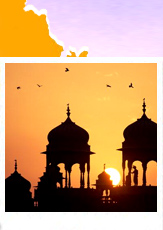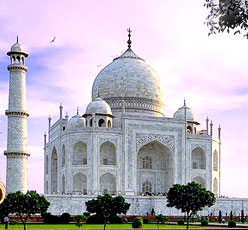 Cellular Jail National Memorial at Port Blair is the most important monument of these islands. It has been a witness to the inhuman tortures meted out to the freedom fighters incarcerated in this Jail. Completed in 1906, this jail came to be known as 'cellular' because it is entirely made up of individual cells intended for the solitary confinement of the prisoners. Out of the 7 prongs, only three have survived and the place is now a pilgrimage for the people who love their motherland and its freedom. all freedom loving people, has been declared a National Memorial. After the First War of Independence in 1857, British transported the most unrelenting patriots to first the awful jails at Viper Island and then the Cellular Jail and most of them used to perish here itself. This was the reason that the place came to be known as Black Water Prison and 'Kala Pani'.
Cellular Jail National Memorial at Port Blair is the most important monument of these islands. It has been a witness to the inhuman tortures meted out to the freedom fighters incarcerated in this Jail. Completed in 1906, this jail came to be known as 'cellular' because it is entirely made up of individual cells intended for the solitary confinement of the prisoners. Out of the 7 prongs, only three have survived and the place is now a pilgrimage for the people who love their motherland and its freedom. all freedom loving people, has been declared a National Memorial. After the First War of Independence in 1857, British transported the most unrelenting patriots to first the awful jails at Viper Island and then the Cellular Jail and most of them used to perish here itself. This was the reason that the place came to be known as Black Water Prison and 'Kala Pani'.Netaji Subash Chandra Bose hoisted the tricolor flag to proclaim Independence on 30th December 1943 at a place near this three-storeyed jail where inhumane atrocities were meted out to the said-convicts or the most influential freedom fighters. It also houses a Museum, an Art gallery and a Photo gallery. Ross Island, the erstwhile capital of Andaman Islands during the British Raj period houses the colonial ruins of old buildings like Ballroom, Chief Commissioner's House, Govt. House, Church, Hospital, Bakery, Press, Swimming Pool and Troop Barracks that are all in dilapidated condition. During British occupation, the island was the seat of power and was developed into a self-equipped civilized town. It was Dr. Walker, Chairman of the Andaman Committee who established the infamous and the dreaded Penal Settlement with 200 convicts.
The British persuaded the tribals to live at Ross Island and established an Andaman Home for them in 1863. Later on, these Andamanese were used to catch the escaping convicts. Navy has established a museum on the Island known as 'Smritika' depicting the history of the Island. It is difficult to imagine what has passed in this tiny, serene, beautiful Viper island where influential freedom fighters proclaimed as dangerous convicts were put in fetters and forced to work with them. Owing to the atrocious working conditions, the jail earned the notorious name of Viper Chain Gang Jail. Gallows were built here on top of a hillock so that all the prisoners can see the execution of the said-convicts. Sher Ali, the Pathan who murdered Lord Mayo was hanged at Viper Island.
Anthropological Museum at Phoenix Bay exhibits the life of the Paleolithic Islanders while Aquarium or Fisheries Museum exhibits species of marine life peculiar to the islands. Samudrika or Naval Marine Museum at Delanipur aims to create awareness on various aspects of oceanic environment and has a good collection of shells, corals and a few species of colorful fishes found in these islands. Zoological Survey of India Museum exhibit a good variety of sponges, corals, butterflies and centipedes while Forest Museum at Haddo offers an insight into forest activities through scale models and displays decorative wood pieces made up of Padauk, Marble, Peauma, Gurjan and Satin Wood.









